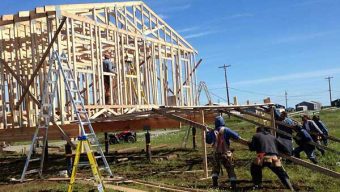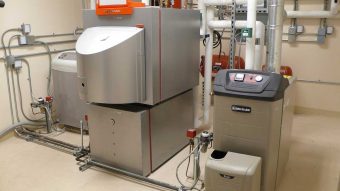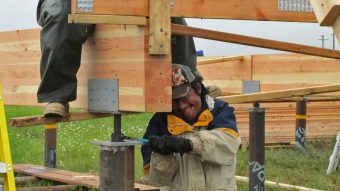Wall Moisture Studies
CCHRC studies various building envelope designs in the Mobile Test Lab, a trailer with nine test wall bays that allows us to test multiple insulation strategies under the same conditions. During active studies, we simulate conditions of a “normal” house inside the Mobile Test Lab. Sensors embedded in the walls record temperature, wood moisture content, relative humidity, and heat flux, providing a side-by-side comparison of the performance of wall designs. Below are some of the studies conducted over the years.
Exterior Foam and the “Double Vapor Barrier” Effect
With the push to retrofit homes, it is important to understand how exterior insulation changes the moisture behavior of walls. By making your home more efficient, are you accidentally creating the potential for rot or mold in your walls?
To lower energy costs, many Alaskans add rigid foam to the home exterior. This decreases the heat lost through the wall, but also creates a potential moisture problem as the foam acts as a second vapor barrier outside the wall. Because most homes have a leaky vapor barrier on the interior side of the wall, this double vapor barrier situation can trap moisture in the walls and potentially lead to mold and rot.
This study looked at retrofit approaches for Interior Alaska, tackling three key questions:
- Does a double vapor barrier cause moisture problems in the dry Fairbanks climate?
- Is there a minimum thickness of exterior insulation that can be added to prevent condensation problems?
- What is the most “materials efficient” way to retrofit an existing home with exterior foam?
In this study, nine test walls were built, each with a different ratio of insulation in the wall cavity (fiberglass batts) and on the exterior of the wall (rigid or spray-on foam). Some walls had leaky vapor barriers and some did not. The 2-year study reaffirmed the idea that foam can act as a “double vapor barrier” by trapping moisture in the walls. It confirmed that any retrofit in Fairbanks using exterior foam insulation should maintain the 2/3 to 1/3 ratio–as long as you place 2/3 of the total wall R-value on the outside of the sheathing, the wall framing stays warm and does not attract condensation. Walls that violated this rule experienced moisture damage and mold.
For results, see the Exterior Insulation Envelope Retrofits in the Subarctic Report and Safe Effective Exterior Wall Retrofits Snapshots 1 and 2.
Using Vapor-Open Insulation for Exterior Retrofits
This project looked at retrofit options that could serve as an alternative for exterior foam board. Insulation types like cellulose or fiberglass, for example, are more vapor permeable than foam and less likely to trap moisture in the wall. A study of seven different test walls produced a few potential candidates for durable, cost-effective retrofits. For example, installing mineral wool or blown-in cellulose insulation in specific ratios both improved the walls’ moisture performance over foam. Results can be seen in the “Safe Effective Affordable Retrofits” snapshot and report below.
 Durable Envelopes for Cold Climates
Durable Envelopes for Cold Climates
A separate study looked at walls with low-density spray polyurethane foam to see how it performed in the Alaska climate. CCHRC worked with industry partners Demilec and Icynene to see whether different types of spray foam insulation could protect the wall from moisture damage.
For results, see the Durable Envelopes report and Cellulose Insulation snapshot.
Southeast Alaska Wall Studies
CCHRC contracted with the University of Alaska Southeast to test wall sections appropriate for Southeast Alaska’s climate in the Mobile Test Lab. The data gained from these studies was used to inform building code and guide local practices for building durable, moisture-safe walls. For results, see the Wall Moisture Study in Southeast Alaska report and snapshot.










